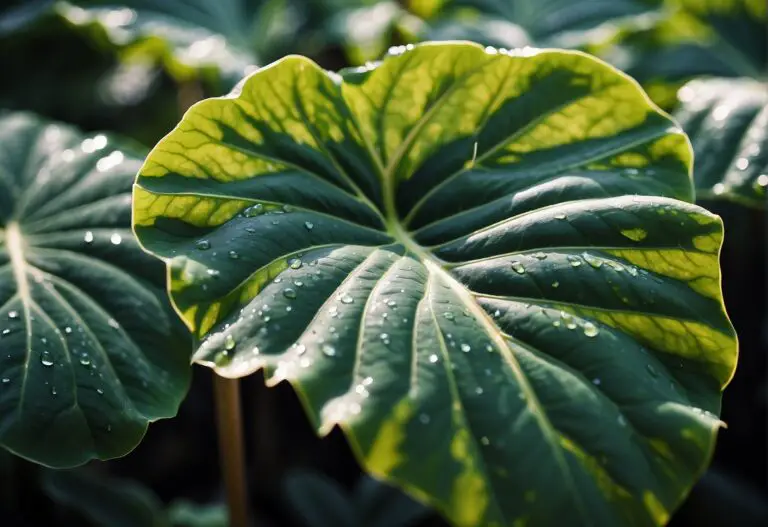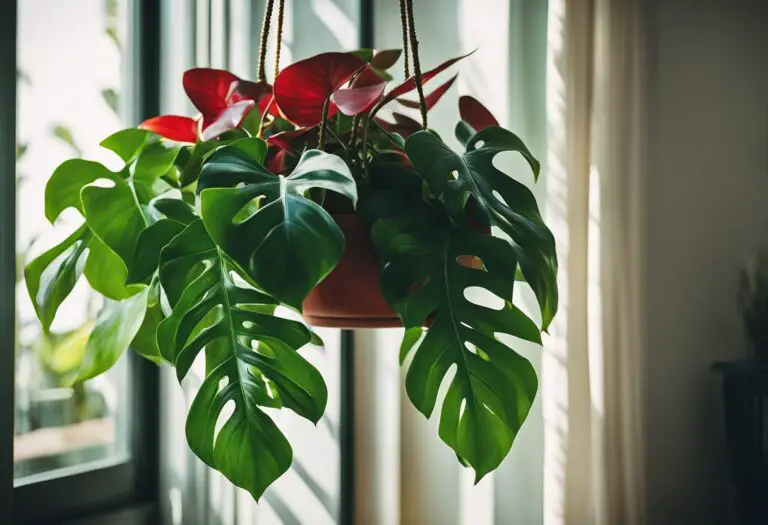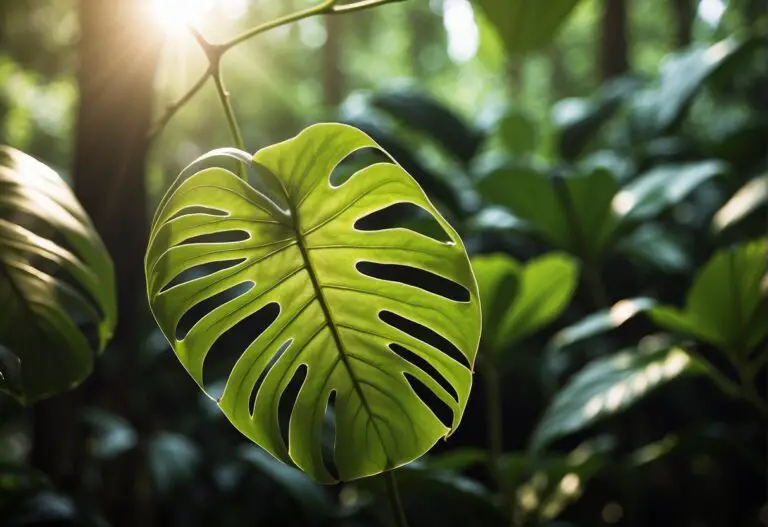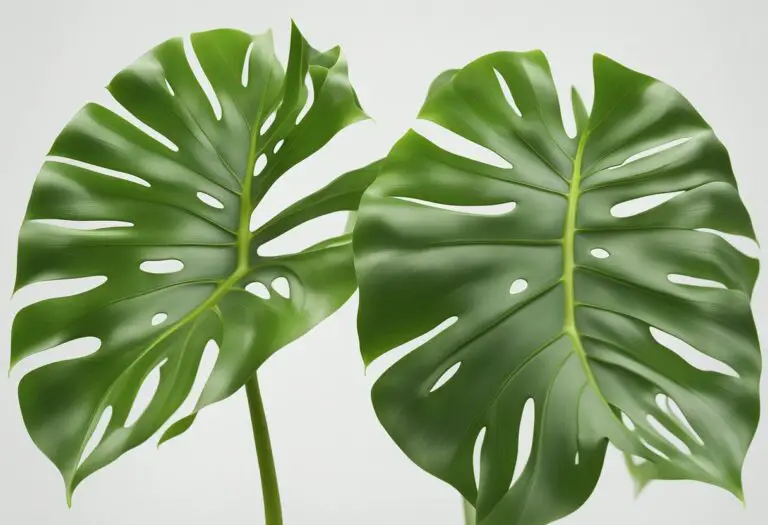Alocasia Platinum Bisma: A Stunning Addition to Your Indoor Garden
If you’re looking for a unique and stunning houseplant, look no further than the Alocasia Platinum Bisma. This tropical plant, also known as the Emerald Dragon Scale, features large, silvery-green leaves with a distinctive texture that resembles dragon scales. Native to Southeast Asia, the Alocasia Platinum Bisma is a member of the Araceae family, which is known for its unique foliage.

Caring for your Alocasia Platinum Bisma is relatively easy, as long as you follow a few key guidelines. This plant prefers bright, indirect light and well-draining soil that is kept consistently moist but not waterlogged.
It also requires high humidity, so you may need to use a humidifier or place a tray of water near the plant to keep the air moist. With the right care, your Alocasia Platinum Bisma can thrive and add a touch of exotic beauty to your home or office.
Key Takeaways
- Alocasia Platinum Bisma is a stunning houseplant with unique silvery-green leaves.
- This tropical plant requires bright, indirect light, well-draining soil, and high humidity.
- With proper care, your Alocasia Platinum Bisma can thrive and add a touch of exotic beauty to your home or office.
Understanding Alocasia Platinum Bisma

If you are looking for a unique and stunning plant to add to your collection, Alocasia Platinum Bisma is definitely worth considering. This tropical plant is known for its striking foliage, which features shades of green and silver and a texture that resembles dragon scales.
Alocasia Platinum Bisma is a member of the Araceae family, which is known for its ornamental plants. This plant is native to Southeast Asia and requires warm temperatures and high humidity to thrive. It can grow up to 3 feet tall and 2 feet wide, making it a great choice for a statement piece in your home or office.
When it comes to caring for Alocasia Platinum Bisma, it is important to keep the soil moist but not waterlogged. You should also avoid exposing the plant to direct sunlight, as this can cause its leaves to burn. Instead, place it in a bright, indirect light and mist the leaves regularly to maintain humidity.
Overall, Alocasia Platinum Bisma is a beautiful and unique plant that is sure to impress. With proper care and attention, it can thrive in your home or office and provide you with years of enjoyment.
Caring for Your Alocasia Platinum Bisma

Alocasia Platinum Bisma is a beautiful and striking plant that can add a touch of elegance and sophistication to any space. To keep your Alocasia Platinum Bisma healthy and thriving, it is important to provide it with the right care. Here are some tips on how to care for your Alocasia Platinum Bisma.
Optimal Lighting
Alocasia Platinum Bisma thrives in bright, indirect sunlight. Direct sunlight can cause the leaves to burn, so it’s best to keep your plant away from windows that receive direct sunlight.
If you don’t have a spot that receives bright, indirect sunlight, you can use artificial light to provide your plant with the light it needs. Place your plant under a grow light for 12-14 hours a day.
Watering Requirements
Alocasia Platinum Bisma likes to be kept moist, but not wet. Water your plant when the top inch of soil feels dry to the touch. Be sure to use room temperature water and avoid getting water on the leaves, as this can cause them to rot. Overwatering can lead to root rot, which can be fatal to your plant.
Soil and Fertilization
Alocasia Platinum Bisma prefers well-draining soil that is rich in organic matter. You can use a high-quality potting mix that contains peat moss, perlite, and vermiculite.
Fertilize your plant once a month during the growing season with a balanced fertilizer. Be sure to follow the instructions on the fertilizer package and avoid over-fertilizing, as this can damage your plant.
Temperature and Humidity
Alocasia Platinum Bisma prefers warm temperatures and high humidity. Keep your plant in a room that is between 65-80°F (18-27°C) and provide it with a humidifier or place a tray of water near the plant to increase humidity.
Avoid placing your plant near drafty windows or doors, air conditioning vents, or heating sources, as this can cause the leaves to dry out and become damaged.
By following these tips, you can ensure that your Alocasia Platinum Bisma stays healthy and beautiful for years to come.
Propagation Techniques
If you want to propagate your Alocasia Platinum Bisma, you have two primary options: division and stem cuttings. Both methods are relatively easy and straightforward, and with the right tools and techniques, you can multiply your plant collection in no time.
Division
To propagate your Alocasia Platinum Bisma through division, you’ll need to remove the plant from its pot and separate a clump of roots from the main rootball. Make sure that the clump you choose has at least one healthy stem and several leaves.
Once you’ve separated the clump, repot it into a new container with fresh soil. Water the plant thoroughly and place it in a bright, indirect light. With proper care, your new Alocasia Platinum Bisma should start to grow in a matter of weeks.
Stem Cuttings
Another way to propagate your Alocasia Platinum Bisma is through stem cuttings. To do this, select a healthy stem section with at least one node. Using sterile scissors or pruning shears, make a clean cut directly below the node.
Dip the end of your cutting into rooting hormone powder (optional but recommended) before placing it into moist soil mix. Keep the soil moist and place the cutting in a bright, indirect light. With proper care, your new Alocasia Platinum Bisma should take root in a matter of weeks.
Remember that propagating plants takes patience and care. With the right techniques and a little bit of practice, you can easily multiply your Alocasia Platinum Bisma collection and enjoy these beautiful plants in every corner of your home.
Common Pests and Diseases
Alocasia Platinum Bisma is a beautiful plant that can add a touch of elegance to any home. However, like all plants, it is susceptible to pests and diseases. In this section, we will discuss some of the most common pests and diseases that can affect your Alocasia Platinum Bisma and how to prevent and treat them.
Identifying Common Pests
Mealybugs and spider mites are the most common pests that can infest your Alocasia Platinum Bisma. Mealybugs are small, white, cotton-like insects that can be found on the undersides of leaves and along stems.
Spider mites are tiny, red or brown insects that can spin webs on your plant. These pests can cause damage to your plant by sucking sap from the leaves and stems, which can lead to yellowing and wilting of the leaves.
Disease Prevention and Treatment
Preventing diseases in your Alocasia Platinum Bisma is essential to keep it healthy and beautiful. One of the most important things you can do is to avoid overwatering your plant. Overwatering can lead to root rot, which can cause your plant to wilt and die. To prevent root rot, make sure the soil is well-draining and only water your plant when the top inch of soil is dry.
If you notice any signs of disease on your Alocasia Platinum Bisma, such as yellowing or wilting leaves, it is essential to act quickly. One of the most effective treatments for a diseased plant is to isolate it from other plants to prevent the spread of the disease. You can also try spraying your plant with a mixture of water and neem oil, which can help to kill off any pests or diseases.
Design and Styling Tips
Pot Selection
Choosing the right pot for your Alocasia Platinum Bisma is important to ensure its growth and health. The pot should be big enough to allow the plant to grow, but not too big that the soil stays wet for too long. It is recommended to use a pot with drainage holes to prevent water from accumulating at the bottom.
You can use a variety of pots to style your Alocasia Platinum Bisma. Terracotta pots are great for a rustic and natural look, while ceramic pots offer a more modern and sleek appearance. You can also choose a pot with a unique design or color to add personality to your space.
Placement Ideas
Alocasia Platinum Bisma is a stunning plant that can add a touch of elegance to any room. It is important to place the plant in a spot that receives bright, indirect light. Direct sunlight can damage the leaves, so it is best to avoid placing the plant in direct sunlight.
You can style your Alocasia Platinum Bisma in a variety of ways. It looks great as a standalone plant, but you can also group it with other plants to create a beautiful indoor garden. You can also place the plant on a plant stand or in a hanging planter to add height and dimension to your space.
Remember to keep your Alocasia Platinum Bisma away from drafts and extreme temperatures. With the right pot and placement, your Alocasia Platinum Bisma will thrive and bring life to your space.
Frequently Asked Questions
How do I properly care for an Alocasia Platinum Bisma?
To properly care for your Alocasia Platinum Bisma, make sure to place it in bright, indirect light and water it thoroughly when the top inch of soil is dry. Keep the humidity around the plant high and avoid letting it sit in standing water. Fertilize once a month during the growing season with a balanced fertilizer.
What are the differences between Alocasia Bisma and Alocasia Platinum Bisma?
While both plants are members of the Alocasia family, the Alocasia Bisma has green leaves with white veins, while the Alocasia Platinum Bisma has silver-green leaves. The Alocasia Platinum Bisma is also a bit more rare than the Alocasia Bisma.
What is the typical size of an Alocasia Platinum Bisma?
The Alocasia Platinum Bisma can grow up to 2-3 feet in height and 1-2 feet in width when fully mature.
Where can I find an Alocasia Platinum Bisma for purchase?
You can find an Alocasia Platinum Bisma for purchase at your local nursery or online plant store.
What is the price range for an Alocasia Platinum Bisma?
The price range for an Alocasia Platinum Bisma varies depending on the size and availability, but typically ranges from $50 to $150.
Why might some gardeners find Alocasia plants challenging to grow?
Alocasia plants can be challenging to grow because they require high humidity, consistent watering, and bright, indirect light. They are also sensitive to overwatering and can be susceptible to pests and diseases if not properly cared for.






